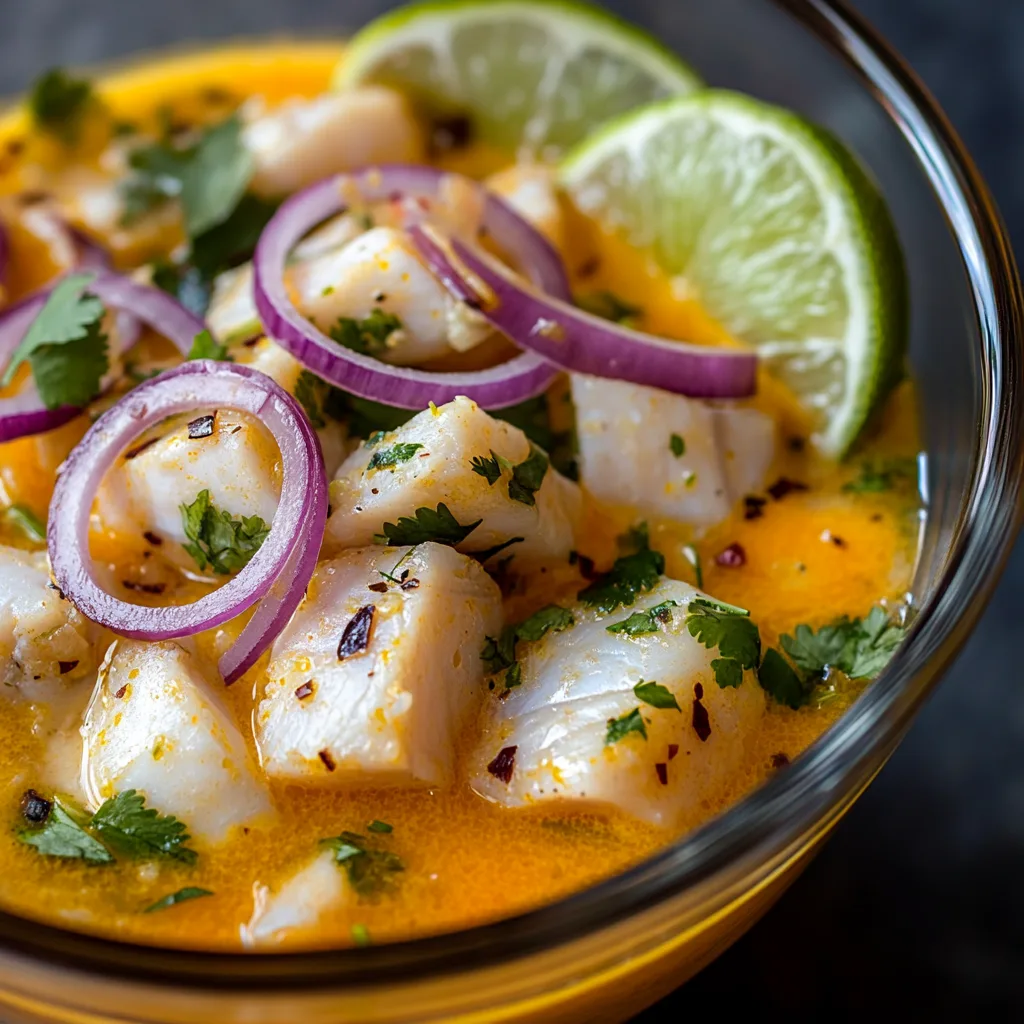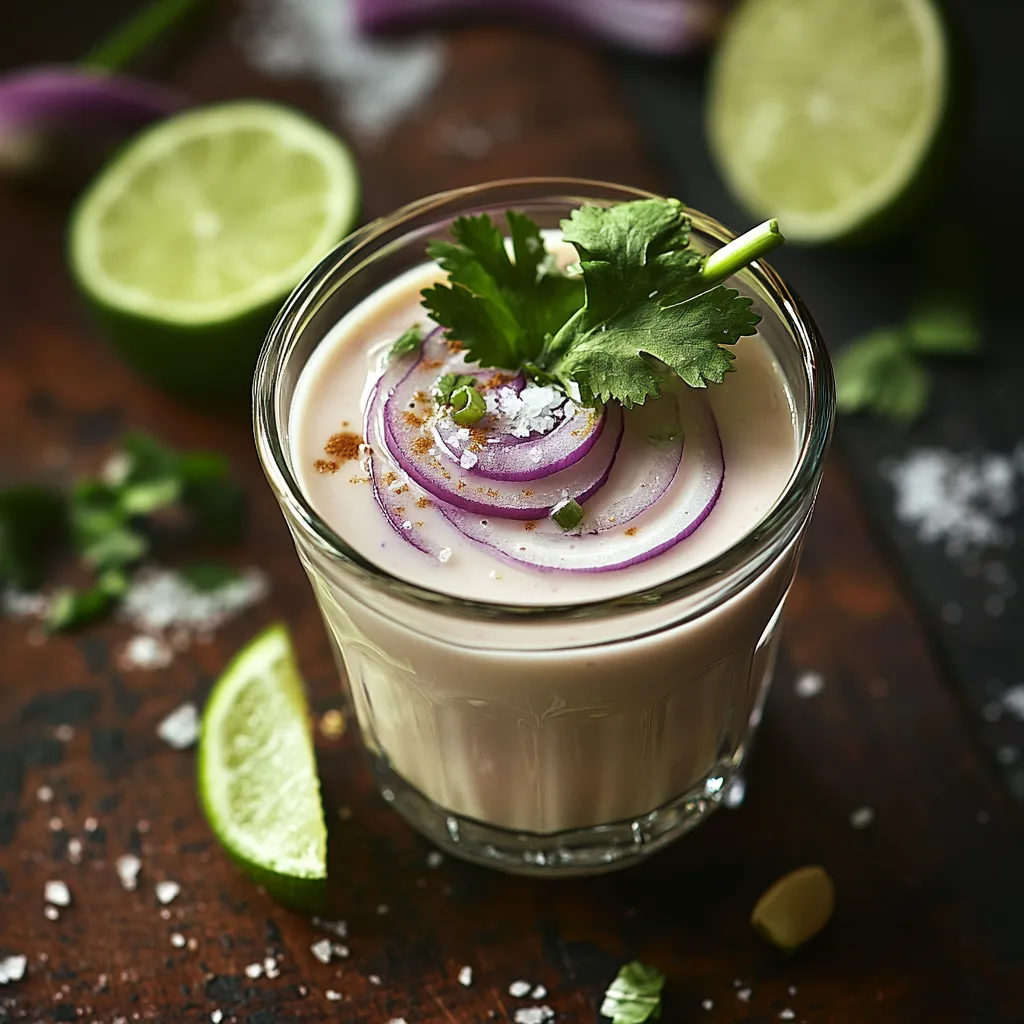
Let’s talk about something truly amazing: the Leche de Tigre recipe. If you’re a fan of bright, zesty, and utterly addictive flavors, then you’ve come to the right place. This Leche de Tigre recipe captures the essence of Peruvian cuisine, showcasing bold citrus and spice in every bite. Often called ‘tiger’s milk,’ this Peruvian elixir is more than just a marinade; it’s a culinary experience. In this article, we’ll explore what makes the Leche de Tigre recipe so special, how to perfect it, and even troubleshoot any hiccups that might come your way. By the end, you’ll be ready to make the ultimate Leche de Tigre recipe like a seasoned pro. Get ready to have your tastebuds do a happy dance!
What is Leche de Tigre, Anyway?
So, before we jump headfirst into the kitchen, let’s get clear on what the Leche de Tigre recipe actually is. At its heart, the Leche de Tigre recipe is all about creating a citrus-based marinade, typically used in Peruvian ceviche. But it’s not your average marinade—it’s the vibrant, flavorful liquid leftover after the fish has been ‘cooked’ in lime juice. This Leche de Tigre recipe combines a punchy mix of acidity, spice, and freshness that will wake up your senses. It’s not just a liquid; it’s a powerhouse of flavor that can transform any dish. You could think of it as the secret sauce of Peru—and now, you’re about to master the Leche de Tigre recipe like a pro!
Print
The Secret to Authentic Leche de Tigre
- Total Time: 30 minutes
- Yield: 2-3 servings
- Diet: Gluten Free
Description
A vibrant and zesty Peruvian marinade, often called “tiger’s milk,” used in ceviche and other dishes. It’s a flavorful combination of citrus, spice, and freshness that can transform any meal.
Ingredients
- Fresh white fish (sea bass, snapper, corvina, etc.)
- Freshly squeezed lime juice
- Red onion
- Aji Amarillo paste
- Fresh cilantro
- Garlic cloves
- Optional: Ginger, Celery, Fish Broth, Sugar/Honey
- Salt and Pepper to taste
Instructions
- Cut the fresh white fish into small, bite-sized cubes.
- Thinly slice the red onion.
- Mince the garlic and chop the cilantro.
- In a non-reactive bowl, combine the fish, red onion, aji amarillo paste, minced garlic, and chopped cilantro.
- Pour in freshly squeezed lime juice, ensuring the fish is mostly submerged.
- Add any optional ingredients like ginger or celery, to taste.
- Gently mix all ingredients together.
- Let the mixture rest for 10-15 minutes until the fish turns opaque.
- Taste and adjust for salt, spice, and sweetness as needed.
Notes
- Use the freshest fish possible.
- Freshly squeezed lime juice is essential.
- The resting time is critical for flavor melding.
- Prep Time: 15 minutes
- Cook Time: 15 minutes (resting time)
- Category: Marinade/Sauce
- Method: No-cook / Acid “cooking”
- Cuisine: Peruvian
Nutrition
- Serving Size: 1/2 cup
- Calories: 100-150
- Sugar: 2-5g
- Sodium: 100-200mg
- Fat: 2-5g
- Carbohydrates: 5-10g
- Fiber: 1-2g
- Protein: 15-20g
Keywords: Leche de Tigre recipe, tiger’s milk recipe, Peruvian marinade, ceviche marinade, aji amarillo, lime marinade, peruvian leche de tigre, peruvian tiger milk, how to make leche de tigre
The History Behind the “Tiger’s Milk”
The roots of Leche de Tigre run deep into Peruvian culinary history. It’s believed that the technique of “cooking” fish in citrus juices dates back centuries, to the ancient Inca civilization. They were masters at preserving food in creative ways, and they discovered that the acidity of limes could alter the texture of fish and make it safe to eat. Over time, this method evolved and became a staple of the coastal regions of Peru, eventually giving birth to what we know today as Leche de Tigre. It’s a beautiful example of how necessity can truly be the mother of invention.
Why is it Called Leche de Tigre?
This is where the fun part comes in! The name “Leche de Tigre,” or “tiger’s milk,” is a bit of a mystery. Some say it refers to the power or “kick” you get from the spicy, citrusy liquid. You know, that jolt of flavor that makes you feel like you can conquer anything? Others believe it’s because the marinade gives you a burst of energy, like a shot of pure tiger strength. Whatever the reason, the name is definitely catchy! Personally, I like to think it’s the magical flavor that leaves you feeling fierce and ready to take on the day.
Essential Ingredients for Your Leche de Tigre

Now, let’s get down to the nitty-gritty: the ingredients. The magic of Leche de Tigre is in its simplicity, but each component plays a vital role in achieving that perfect balance of flavors. You don’t need a pantry full of exotic spices; just a few key ingredients, and you’re golden. So grab your shopping list and let’s get cooking!
The Core Components: Fish, Lime, and Onions
First and foremost, we need fish. Traditionally, a firm, white fish is used, such as sea bass, snapper, or corvina. But we’ll talk more about options later. Then, you absolutely cannot make Leche de Tigre without a healthy dose of lime juice. Freshly squeezed is a must—don’t even think about using the bottled stuff! And lastly, we need thinly sliced red onions. These guys add a nice sharpness and a bit of texture to our liquid gold.
The Flavor Boosters: Aji Amarillo, Cilantro, and Garlic
Next up, it’s time to amp up the flavor. Aji Amarillo paste is a key ingredient. This yellow pepper paste has a fruity, slightly spicy flavor that is uniquely Peruvian. It’s what gives Leche de Tigre that signature warmth. Don’t worry if you can’t find it; we’ll talk substitutes later. Fresh cilantro adds a bright, herbal note, and a clove or two of garlic brings a pungent depth that pulls everything together. These three ingredients are like the band that make the music sing.
Optional but Awesome: Ginger, Celery, and More
While the above ingredients are essential, there are some optional additions that can really elevate your Leche de Tigre. A knob of ginger adds a nice spicy kick and a bit of warmth, while a stalk of celery can bring in a subtle, fresh, earthy note. Some people even add a little bit of fish broth for extra depth, or a touch of sugar to balance the acidity. These additions are all about personal preference, so feel free to experiment and find your perfect combination! Remember, cooking should be fun!
Step-by-Step: Crafting Your Leche de Tigre From Scratch
Alright, now that we’ve gathered our ingredients, let’s get our hands dirty (metaphorically speaking, of course!). Making Leche de Tigre is actually quite simple, but there are a few key steps to keep in mind to ensure you get the best flavor. Think of it like following a dance – each move is essential to the final result. So, let’s put on our chef hats and get to it!
Preparing the Fish: Choosing the Right Cut
The first step is all about the fish. As I mentioned before, you’ll want a firm, white fish. The key is to make sure it’s super fresh! Now, you don’t need to be a master fishmonger to handle this step. Simply cut your fish into small, bite-sized pieces, about ½ inch cubes. The idea is to create surfaces for the lime juice to work its magic. And remember, freshness is king! If your fish doesn’t smell like the ocean, skip it!
The Secret to Squeezing the Perfect Lime Juice
Now, for the star of the show: lime juice. This isn’t just about grabbing a few limes and squeezing them; it’s about getting every last drop of deliciousness. First, roll your limes on the countertop with a bit of pressure; this helps release the juices. Next, cut them in half and squeeze them into a bowl, removing any seeds or pulp. And a pro tip? Never squeeze too hard! You want to extract the juice, not the bitter oils from the skin. Using a good citrus juicer can make this step a breeze!
Blending it All Together: Achieving the Right Consistency
Okay, here comes the fun part where we bring all the ingredients together. In a glass or non-reactive bowl, combine the cubed fish, red onion slices, aji amarillo paste, minced garlic, and chopped cilantro. Now, pour in that freshly squeezed lime juice, making sure the fish is mostly submerged. Gently mix everything together, ensuring every piece of fish is coated in the lime mixture. At this point, you can also add any of those optional ingredients we discussed, like a little ginger or celery. The final step is to let the mixture sit for at least 10-15 minutes, so the lime juice can work its magic on the fish. This process “cooks” the fish with acid. Don’t skip this resting time; it’s critical for the flavor to meld properly. You should see the fish turn from translucent to opaque – this means it’s ready! This step is like letting the flavors flirt before they commit to a harmonious relationship.
Mastering the Art of Flavor: Balancing Act
Leche de Tigre is all about balancing four key flavor profiles: sweet, sour, salty, and spicy. Think of it as an orchestra, where each instrument has to play its part perfectly to create a beautiful symphony. It’s a delicate dance, but once you understand the basics, you can become a true maestro of flavor!
The Sweet, Sour, Salty, and Spicy Symphony
The sour comes primarily from the lime juice. This bright acidity is the foundation of the whole dish. The salty element usually comes from the fish itself, but you might want to add a pinch of sea salt or a dash of fish sauce. The aji amarillo is the key ingredient for that spicy kick but, it should be subtle and not overwhelming. And finally, you might find that a tiny bit of sweetness is needed to balance out the sourness – you can use a pinch of sugar, a tiny bit of honey, or agave syrup. The idea is that no one flavor overpowers the others, instead creating a perfectly balanced taste. ⚖️
Tasting and Adjusting: Your Personal Touch
Now, here’s the best part: tasting and adjusting! Once your mixture has rested, grab a spoon and have a taste. Is it too sour? Add a touch of sweetness. Not spicy enough? Add a little extra aji amarillo or a dash of your favorite hot sauce. Does it need more salt? Now’s the time to tweak it. This is where you get to put your own personal spin on the recipe. Don’t be afraid to experiment a little. Remember, cooking should be fun and an adventure. You are the master of your flavor journey!
Common Leche de Tigre Problems and How to Fix Them!
Okay, sometimes things don’t go exactly as planned in the kitchen. Don’t worry; we’ve all been there! The good news is that most common Leche de Tigre problems are easily fixed. Let’s troubleshoot some common issues, shall we?
Too Sour? Not Enough Kick? Let’s troubleshoot
Is your Leche de Tigre making your face pucker? If it’s too sour, this means you need to add a little sweetness. A pinch of sugar or a teaspoon of honey can do wonders. Conversely, if it lacks that punchy flavor you were hoping for, add a little more aji amarillo paste, some minced jalapeno, or a dash of your favorite hot sauce. Remember, it’s all about finding the balance that works best for you. You are the boss of your own tastebuds!
The Fish Tastes “Fishy”: Avoiding Common Mistakes
If your fish tastes overly “fishy,” it’s likely due to the quality of the fish. Always use the freshest fish you can find. If it’s not smelling fresh, it’s a no-go. Also, make sure that you use a non-reactive bowl. Metal bowls can sometimes impart a metallic taste that can ruin a great recipe. Glass, ceramic, or plastic are your best bet. And don’t let your fish sit in the lime juice too long! The goal is to gently “cook” it, not pickle it.
The Texture is Off: Getting it Right
The texture of Leche de Tigre should be somewhat thin and slightly cloudy. If it’s too thick, you can add a little water or even some fish broth to thin it out. If it seems watery, you might have added too much liquid, but don’t worry! A quick fix is to add a few more pieces of the fish that can absorb some of the extra moisture. The trick is to get the balance between a light and flavorful sauce, not a heavy one.
“Cooking is at once child’s play and adult joy. And cooking done with care is an act of love.” – Craig Claiborne
Variations and Twists: Leche de Tigre, Reimagined
Now that you’ve mastered the classic Leche de Tigre, let’s get a little creative! The beauty of this recipe is its versatility. You can easily adapt it to suit your tastes and preferences. It’s like having a blank canvas – let your culinary imagination run wild!
Spicy Kick: Adding Habaneros or Other Chili
For those who like to turn up the heat, adding a habanero or some other chili pepper is a great way to spice things up! A little minced habanero goes a long way, so start with a small amount and add more to taste. You could also use serrano peppers or even a dash of your favorite hot sauce. Just be careful – you can always add more spice, but it’s hard to take it away once it’s there!
Creamy Indulgence: The Addition of Coconut Milk
If you’re looking for a smoother, creamier Leche de Tigre, a splash of coconut milk is a great addition. It adds a touch of sweetness and richness that balances beautifully with the acidity of the lime. Just whisk it in at the end, and you have a decadent twist on the classic recipe. It’s a little like taking a tropical vacation in your mouth!
Seafood Adventure: Beyond the Classic White Fish
While white fish like sea bass and snapper are traditionally used, don’t be afraid to experiment with other types of seafood. Shrimp, scallops, or even octopus can be delicious alternatives. Just be sure to adjust the cooking time if necessary. A firmer fish can stand a little longer in the marinade, while more delicate seafood should only sit for a shorter amount of time. It’s all about having fun and exploring!
Serving Suggestions: Elevating Your Leche de Tigre Experience

Leche de Tigre is a flavor bomb that can be used in so many different ways. It’s not just a marinade; it’s a versatile sauce that can transform a variety of dishes. Let’s explore some creative serving ideas!
The Classic Pairing: As a Ceviche Marinade
Of course, the classic way to serve Leche de Tigre is as a marinade for ceviche. The fish is “cooked” in the lime juice, resulting in a tender, flavorful dish that’s perfect for a light meal or appetizer. You can serve it with some sweet potato, cancha (toasted corn), and some additional red onion slices. This is the authentic Peruvian experience!
Beyond Seafood: Drizzling Over Tacos and Salads
Don’t limit yourself to just seafood! Leche de Tigre is also delicious drizzled over tacos, especially fish or shrimp tacos. Its zesty flavor brightens up any dish. It can also elevate a simple salad into something special. The citrusy, spicy notes complement greens, grilled veggies, or even avocado perfectly. It’s a game changer!
The Perfect Leche de Tigre Shooter: Sip and Enjoy
For a truly unique experience, try serving Leche de Tigre as a shooter. It’s a perfect appetizer that will awaken your taste buds and prepare you for a great meal. Just pour a small amount into a shot glass and garnish with a sliver of red onion or a sprig of cilantro. It’s a delicious and exciting way to enjoy the flavor explosion!
Leche de Tigre: Your New Favorite Culinary Adventure
You’ve come a long way, from learning what Leche de Tigre is to crafting your own batch and now imagining new ways to enjoy it. It’s more than just a recipe; it’s an adventure into a world of vibrant flavors and culinary possibilities.
From Peru to Your Kitchen: A Global Culinary Journey
Leche de Tigre is a testament to the power of simple ingredients and bold flavors. It has traveled all the way from the coast of Peru to kitchens around the world, bringing a little bit of sunshine with each serving. By making it at home, you are partaking in a global culinary journey, connecting to a rich tradition and culture. Isn’t that amazing?
Why You Need This Recipe In Your Life!
Seriously, why wouldn’t you want this recipe in your life? It’s easy to make, full of flavor, versatile, and can be customized to your exact liking. Whether you’re a seasoned chef or a beginner in the kitchen, Leche de Tigre will definitely impress your friends and family, and most importantly, yourself. It’s an absolute must-try!
“One of the very nicest things about life is the way we must regularly stop whatever it is we are doing and devote our attention to eating.” – Luciano Pavarotti
Beyond Leche de Tigre: Exploring Culinary Delights
While Leche de Tigre is a star in its own right, the world of flavor extends far beyond! If you’re feeling inspired to explore other culinary adventures, why not try your hand at crafting a sophisticated Ultimate Branzino Recipe? Or perhaps you’re seeking a boost of wellness; discover the remarkable Elderberry Juice Benefits, Uses, and How to Choose. For a lighter, yet equally satisfying option, consider a twist on a classic with Avocado Toast with a French Twist. If you’re craving a refreshing citrus burst, explore the vibrant world of Blood Orange Juice Benefits, Recipes, and Guide. And for those moments when you want to indulge in a simple pleasure, find out What are the Positives about Hot Fries. Culinary exploration is a journey, and the possibilities are as endless as your imagination!
Frequently Asked Questions About Leche de Tigre
Let’s tackle some of the most common questions people have about Leche de Tigre.
Can I make it ahead of time?
Yes, you can make Leche de Tigre ahead of time, but it’s best to add the fish just before serving. The marinade can be made a few hours in advance and stored in the fridge. This will give the flavors a chance to meld together. Just don’t let the fish sit in the lime juice for too long!
How long does it last in the fridge?
Leche de Tigre without the fish can last for up to 2 days in the refrigerator. But, the flavor might change a little over time, so it’s best to use it fresh. If the fish is already in the mixture, it’s best to consume it within a few hours.
Is it safe to eat raw fish?
Yes, it’s generally safe to eat fish that has been “cooked” in the acidity of the lime juice, but it must be fresh. The acid in the lime juice kills most of the bacteria and parasites. But if you are concerned about eating raw fish, you can use cooked shrimp or other seafood.
What’s a good vegetarian alternative to fish?
If you’re not a fan of seafood, you can still enjoy Leche de Tigre! Use cooked hearts of palm, firm tofu, or even mushrooms as a substitute. These can stand the acidity of the marinade, and they soak up the flavors well. You might even discover a new favorite variation!
